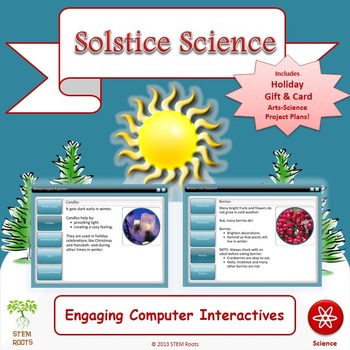NGSS Earth & Space: "Solstice Science" STEM Unit |1-ESS1-1, -2
- Zip
Also included in
- This bundle contains five immersive lesson plans plus an eventual engineering bonus pack aligned to the Next Generation Science Standard for first grade. Each lesson plan includes complete lesson plan instructions, interactive PowerPoint presentations, corresponding e-learning activity, labs, workshPrice $42.36Original Price $52.95Save $10.59
- This bundle is my best value for NGSS first grade. It contains an five immersive lesson plans aligned to the Next Generation Science Standard for first grade--plus all eight of my Biomimicry Discovery Cards (48 cards/8 biomes).ABOUT THE BIOMIMICRY DISCOVERY CARD KIT EXPANSION:Expand Trait MountainPrice $64.76Original Price $80.95Save $16.19
- This is my combo-pack for my popular Solstice Science and Astro Observatory NGSS science units! Buy the combo pack and save on six weeks of science lesson plans! Or, purchase the complete NGSS 1 Bundle for more units and savings!! RELATED RESOURCE: • NGSS Grade 1 Bundle: Complete STEM CurriculumPrice $16.19Original Price $17.99Save $1.80
Description
Teach your K-3 students about the science behind the winter season with three engaging lessons.
***VIEW THE DEMO***
View demo (with intro screens and a few sample interactions only) here.
Learn how winter traditions are a reflection of changes in the Earth during this darker, colder season.
Students will learn about:
❄ Winter lights--candles, lights and fires--and winter life--seeds, evergreens and berries--as signs of changes in sunlight during winter.
After a computer interactive presentation, students will observe three winter life specimens--including evergreen and deciduous tree branches, and pinecones--and note their observations on provided worksheets.
❄ How the tilt of the sun in winter results in less sunlight due to indirect exposure.
After a computer interactive, students will construct their own model of the earth in winter and summarize their learning in pictures and writing.
❄ Ways to measure changes in light exposure between winter and summer solstice.
Students will make a "Shadow Simulator" to discover how shadows change with the seasons and record their observations.
Then, to align with NGSS, students will observe seasonal changes monthly between winter and spring or summer. They will log what their class wears over time, how shadow length changes on the playground, and what changes they observe in plant and animal life in a science journal. Logs are differentiated with the more complex one including math computation.
❄ ❄ BONUS STEAM PROJECT: Students will make a candle holder craft and poetry greeting card that synthesizes learning. The poetry assignment includes a graphic organizer.
Lesson plans combine a series of:
• engaging hands-on activities
• observation labs
• writing exercises
• 3D dioramas
• computer interactives
Interactives run on Flash, PowerPoint viewer and MS Excel. They are versatile enough to be used:
• On any computer with a classroom projector
• With a smart whiteboard (or interactive flipchart)
• On a PC in a homeschool setting
This is an excellent way to incorporate science into your January and February lesson plans! It can also stand alone.
SOLSTICE SCIENCE IS ALSO INCLUDED IN THESE BUNDLES:
• NGSS Earth & Space Combo: "Solstice Science" & "Astro Observatory" Units
• NGSS Grade 1 Bundle: Complete STEM Curriculum
• NGSS First Grade Super Bundle: Complete STEM Curriculum w/Biomimicry Expansion (BEST VALUE!)
★ Follow me! Click the star (★) beneath my STEM Roots store name above to be the first to know about freebies, new product listings and more!
! Terms of Use: This product gives the End User (purchaser) the right to use the lesson plans in their classroom. Please purchase one additional, discounted multi-seat license per classroom if sharing with additional classrooms or for school district use. Thank you!
All projects are aligned to Common Core State Standards (CCSS) and Next Generation Science Standards (NGSS). See preview file for lesson overview and standards alignment.
Keywords: winter, lights, collaborate, collaborative, multisensory, solstice, season, tilt, axis, hemisphere, equator, pole, snow, ice, fire, gift, orbit, latitude, sunlight, seed, berries, berry, pine cone, pinecone, senses, space, solar system, NGSS 1-ESS1-2, NGSS 1.ESS1.2.








